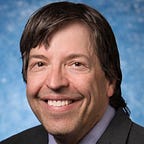Dinner with Dyson
Encountering the Wit and Charm of an Extraordinary Physicist
November 9, 2016 was a crazy day in American political life. The country was experiencing the aftershocks of the widely unanticipated outcome of a Presidential election. A gathering at the Institute for Advanced Study (IAS) in Princeton, NJ, offered the opportunity for European scientists to console and reassure the rather stunned American scientists.
The event was a celebration by the European Physical Society and the American Physical Society of their second joint historical plaque. Both plaques celebrated the work of Albert Einstein. The first honored the house in Bern, Switzerland where he produced some of his most famous work during his Annus Mirabilis (miracle year) of 1905. Providing balance, the second, at the IAS, honored the esteemed institution with which he was associated from 1933 until his death in 1955.
Along with the plaque ceremony was a signing ceremony of the APS Historic Site Book. For those, my role, as Chair of the APS Historic Sites Committee, was to help officiate over the event and make sure everything went smoothly. It was delightful meeting IAS Director Robbert Dijkgraaf, much lauded IAS physicist Ed Witten, EPS President Christophe Rossel, APS President Homer Neal, and many other luminaries. (Sadly, Homer Neal has since passed away).
After the ceremony we were treated to a special dinner at the IAS Dining Hall. Much to my delight and astonishment I was seated next to long-time IAS member, brilliant physicist Freeman Dyson. Although I had met Prof. Dyson once before, at an event honoring the 90th birthday of John Wheeler, had corresponded with him, and had suggested him for an Honorary Degree at the University of the Sciences (for which he accepted and gave an excellent speech), the dinner would offer the perfect chance to get to know him better.
As we sat down for dinner, I brought up the political situation. Dyson, who was a renegade thinker in many ways, open to considering a wide range of views, said that he had anticipated a populist rebellion against the establishment. Thus the election results didn’t come as a surprise to him.
Our conversation soon turned to science. Dyson brought up the scientific thinker William Herschel, a noted astronomer and musician, who lived in England during the time of his discovery of Uranus. I asked Dyson:
Did you ever visit the Herschel Museum in Bath?
He said:
No, but I visited the Maritime Museum in Bath.
I said:
I didn’t know Bath was by the sea.
He replied:
Bath, Maine!
We both laughed.
The first course of the meal was an appetizer. The server brought over a dish. She said:
Here is your vegan appetizer, Prof. Dyson!
After we each consumed our respective appetizers, his the vegan version, the next course was fish soup, which I noticed that Prof. Dyson was eating too. I was puzzled, and said to him:
I thought you were vegan.
He replied:
I was!
Once again, we both had a laugh.
At the end of the fancy meal, which to my taste was elegant and delicious, I asked him what he thought about it. His sly response, reflective of his disdain for the posh and formal, was:
Don’t tell my wife, but I’d rather be eating at McDonalds!
At some point, I reminded Dyson about the book I was working on at the time, The Quantum Labyrinth, about the lives and works of Richard Feynman and John Wheeler. He told me a Feynman story I hadn’t heard before. As I recounted Dyson’s story in my book:
One time, a friend of Feynman’s daughter Michelle, whose family was going on vacation, dropped off their pet boa constrictor at the Feynman house for a month of “babysitting.” Much to Feynman’s consternation, the snake’s diet was live mice. After he managed to procure some, he was dismayed to see that the boa constrictor was too languid to catch its prey. Instead, the mice began nibbling on the snake’s skin, disfiguring it. Feynman had to stand guard to protect the pet. Michelle’s friend’s parents were very upset when they returned from vacation to find their “baby” with nibble marks. Never again, Feynman swore.
Also seated at the dinner was Freeman Dyson’s son, historian George Dyson, who gave an excellent talk about the history of the IAS. Freeman Dyson proudly noted that while he never received his PhD, George did him one better by having never received a high school degree. George had fled the USA for Canada during the Vietnam War because of the draft and returned only years later. Nevertheless George (like many other members of the Dyson family) was extremely successful.
After saying goodbye to Freeman Dyson at the dinner, we continued to interact via email.
Freeman Dyson passed away at the age of 96 on February 28, 2020. Like all those who had the pleasure of interacting with him, I feel privileged to have known him and already miss him dearly!
Some of Dyson’s comments and recollections that he emailed me in 2019 will be included in my new book, Synchronicity.
Paul Halpern is a University of the Sciences physics professor and the author of sixteen popular science books, including Synchronicity: The Epic Quest to Understand the Quantum Nature of Cause and Effect.
